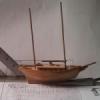-
Posts
8,764 -
Joined
Reputation Activity
-
 cog reacted to Piet in IJN Mikasa by CDW - Wave Models - 1:200 scale - PLASTIC
cog reacted to Piet in IJN Mikasa by CDW - Wave Models - 1:200 scale - PLASTIC
Hi Craig,
Yeah, I use a small file I still have from a previous life. The blade and tang are all one piece with the business end rough but rather fine rough, almost like a 360 grit. It seems to be made from tungsten or other super hard metal and does a nice job wearing away HSS (high-speed steel) without any problem. Not so good on wood though, except hard wood a little. I have also used a VERY fine cut-off wheel in the Dremmel and even a VERY fine aluminum oxide wheel in the Dremmel for the larger sizes like between #60 and 70. When you come to the really small size drills like the #80 you'd better have steady hands and a support, but it works.
I still prefer the little file, have more control over things. Try it and see if you can reuse some of the broken bits.
Here is another tool you may may try and that's a contacter or point file I used in aircraft or car ignition systems. I still have on in my toolbox. Hmmm, that just popped into my mind, I should put that one on my workbench
Cheers,
-
 cog reacted to Dfell in HMS Jason by Beef Wellington - Caldercraft - 1:64 - Artois-class frigate modified from HMS Diana 1794
cog reacted to Dfell in HMS Jason by Beef Wellington - Caldercraft - 1:64 - Artois-class frigate modified from HMS Diana 1794
Agree with BANYAN - stunning work. So clean and tidy - beautiful to look at.
Doug
-
 cog reacted to BANYAN in HMS Jason by Beef Wellington - Caldercraft - 1:64 - Artois-class frigate modified from HMS Diana 1794
cog reacted to BANYAN in HMS Jason by Beef Wellington - Caldercraft - 1:64 - Artois-class frigate modified from HMS Diana 1794
Geez I would like to see that model in real life, it looks great by camera so to the eye it would be stunning.
Nicely done Jason
cheers
Pat
-
 cog reacted to Beef Wellington in HMS Jason by Beef Wellington - Caldercraft - 1:64 - Artois-class frigate modified from HMS Diana 1794
cog reacted to Beef Wellington in HMS Jason by Beef Wellington - Caldercraft - 1:64 - Artois-class frigate modified from HMS Diana 1794
Hi all, trying to get the shipyard going again. Decided to put some additional paint friezes on the lower finishing pieces which are all now glued in place and touched up. Tried to make these a bit subdued, and mirrored a design appearing in one of the moldings at the stem.
Also made up what I think is technically the 'drop' proper, or alternatively the "round thing" which I'd been pondering for a while after committing to not to use the kit white metal parts. The technique devised proved to be pretty easy to execute by simply gluing some 2mm think spare stock onto the end of some 4mm dowel. Using that as a guide to shape to be round and domed - these were then soaked in rubbing alcohol to separate again. I'm waiting to glue these on as I suspect they will be too easy to knock off with the other work remaining to do at the stern.
Next up, I think I'm in a position to start getting some trim on and find out if there are any issues with the placement of the painted letters...
-
 cog reacted to BenD in US Brig Syren by Gahm - Model Shipways
cog reacted to BenD in US Brig Syren by Gahm - Model Shipways
This is some good work right here. I could only wish to have half this craftsmanship someday
-
 cog got a reaction from popeye the sailor in IJN Mikasa by CDW - Wave Models - 1:200 scale - PLASTIC
cog got a reaction from popeye the sailor in IJN Mikasa by CDW - Wave Models - 1:200 scale - PLASTIC
probably a file or a sharpening stone. Sanding sticks tend to run smooth rather quickly ... unless you like to polish
-
 cog got a reaction from CaptainSteve in Venetian Carrack or Cocha by woodrat - FINISHED - 1/64
cog got a reaction from CaptainSteve in Venetian Carrack or Cocha by woodrat - FINISHED - 1/64
Magnificent DIck. It exceeds my expectations ... far!
-
 cog got a reaction from Beef Wellington in HMS Jason by Beef Wellington - Caldercraft - 1:64 - Artois-class frigate modified from HMS Diana 1794
cog got a reaction from Beef Wellington in HMS Jason by Beef Wellington - Caldercraft - 1:64 - Artois-class frigate modified from HMS Diana 1794
Jason,
A "ketelbinkie" is a ship's boy, used for all kind of odd jobs, aged between 12 and 17 (probably younger too). It seems Sjors has miraculously found the fountain of youth ...
Cheers mate, enjoy the trip to your holiday's destination, and have fun, and relax
-
 cog reacted to Gahm in US Brig Syren by Gahm - Model Shipways
cog reacted to Gahm in US Brig Syren by Gahm - Model Shipways
I am finally finished with the gun rigging . The deck is pretty complete by now. I also started with the bowsprit as far as it was necessary to be able to finish the bowsprit bitts without having a bad surprise later on. Below is a selection of views of the current state of my Syren model. Btw, in image 8 it looks like the bowsprit is resting on the head of the figurehead. In reality this is not the case. But as the bowsprit bitts are not yet glued in they came lose during the time I made the photos and the bowsprit hit the head of the poor figurehead .
Thomas
Image 1
Image 2
Image 3
Image 4
Image 5
Image 6
Image 7
Image 8
Image 9
-
 cog got a reaction from mtaylor in Venetian Carrack or Cocha by woodrat - FINISHED - 1/64
cog got a reaction from mtaylor in Venetian Carrack or Cocha by woodrat - FINISHED - 1/64
Magnificent DIck. It exceeds my expectations ... far!
-
 cog reacted to CaptainSteve in Venetian Carrack or Cocha by woodrat - FINISHED - 1/64
cog reacted to CaptainSteve in Venetian Carrack or Cocha by woodrat - FINISHED - 1/64
WoW !! I'd always considered those crazily billowing sails in medieval paintings to be mere artistic licence. But your research and work has shown the truth behind the myths.
Outstanding work, Dick.
-
 cog reacted to woodrat in Venetian Carrack or Cocha by woodrat - FINISHED - 1/64
cog reacted to woodrat in Venetian Carrack or Cocha by woodrat - FINISHED - 1/64
See how the mains'l sets...........
Dick
-
 cog reacted to BANYAN in Young America 1853 by EdT - FINISHED - extreme clipper
cog reacted to BANYAN in Young America 1853 by EdT - FINISHED - extreme clipper
Thanks for taking the time to explain and share the dimensions of your jigs Ed, very much appreciated. Now that I understand the principle it all makes sense and shows the experience you bring with your ideas.
Your YA books are on my Christmas list I have recently trawled your Naiad volumes again, and find the information and practical advice relevant to all model building, kit bashing as well as scratch building any model, very helpful. The Masting and Rigging volume of YA will be particularly valuable as most reference books, except for David Antscherl's Vol 4 of TFFM, only address the principles of these disciplines ;whereas, your effort is written with a more practical aspect of "how to". As YA is more relevant to my era of interest, I will find this log and your forthcoming volume very helpful.
cheers
Pat
-
 cog reacted to RGL in IJN Amatsukaze by Dan Vadas - FINISHED - Halinski - 1:200 scale - CARD and Brass - WW2 Japanese Destroyer -
cog reacted to RGL in IJN Amatsukaze by Dan Vadas - FINISHED - Halinski - 1:200 scale - CARD and Brass - WW2 Japanese Destroyer -
If I may suggest an easy solution to the blast bags, use the plastic backed tin foil on Ferrero Rocher chocolates.
-
 cog reacted to Adrieke in Pilar by Adrieke - Constructo - Scale 1:27
cog reacted to Adrieke in Pilar by Adrieke - Constructo - Scale 1:27
Thanks Carl and Grant
as promised an update on where I am at :
I had a look at what the real Pilar looks like and If possible adapt my build to it. I am a bit confused though as I found pictures of it renovated where they removed most of the air intakes.
-
 cog got a reaction from mtaylor in Enterprise by src - Constructo - 1:51 - or Lessons in Adapt Improvise and Overcome
cog got a reaction from mtaylor in Enterprise by src - Constructo - 1:51 - or Lessons in Adapt Improvise and Overcome
You are ever so welcome my friend
-
 cog got a reaction from mtaylor in Enterprise by src - Constructo - 1:51 - or Lessons in Adapt Improvise and Overcome
cog got a reaction from mtaylor in Enterprise by src - Constructo - 1:51 - or Lessons in Adapt Improvise and Overcome
Looks splendid Sam. Your boss is Indian I presume. I especially like the intricacies of those geometric panels behind/around the lamp
-
 cog got a reaction from mtaylor in Modern Yachts by albergman - FINISHED - half-hull
cog got a reaction from mtaylor in Modern Yachts by albergman - FINISHED - half-hull
Magnificent those railings!
-
 cog got a reaction from src in Enterprise by src - Constructo - 1:51 - or Lessons in Adapt Improvise and Overcome
cog got a reaction from src in Enterprise by src - Constructo - 1:51 - or Lessons in Adapt Improvise and Overcome
You are ever so welcome my friend
-
 cog reacted to druxey in Young America 1853 by EdT - FINISHED - extreme clipper
cog reacted to druxey in Young America 1853 by EdT - FINISHED - extreme clipper
Excellent mod to the spar holder to accommodate tapered sticks! Brilliant solution, Ed.
-
 cog reacted to michael mott in Young America 1853 by EdT - FINISHED - extreme clipper
cog reacted to michael mott in Young America 1853 by EdT - FINISHED - extreme clipper
Ed, once again thank you for your dedication to teaching us about your methods and technical information. I look forward to being set up again to implement some of the ideas that you have illustrated. The curving of the spar jig is a great idea, I see other applications for this one as well, sometimes when flattening a warped sheet a device like this has potential. instead of just pulling down the centre one could warp the base to match the warp in the sheet, then plane the top side flat. In my view this is better than shimming up the offending corner or corners.
I take possession of the new shop next Wednesday.
Michael
-
 cog reacted to EdT in Young America 1853 by EdT - FINISHED - extreme clipper
cog reacted to EdT in Young America 1853 by EdT - FINISHED - extreme clipper
Thanks for these comments and questions.
Alan, below is a picture that I think shows what you want.
The grooves are simply v-grooves of a few different depths to accomodate different size of spar. Dowel stubs are inserted at the end as stops.
Pat, this picture should help answer your question. I apologize for the brief cryptic explanation of the curving of the bed, so I will expand a bit. In the picture the center of the bed is being depressed by tightening one of the two screws placed on the center line of the bed for this purpose. The picture shows one of the masts. These masts have their maximum diameter at the partners and taper down in both directions in a curve. Yards are similarly curved from the center to the ends. Curving the bed of the fixture to roughly fit this curvature allows the spar to lay flat on it entire length so it does not rock when shaping. This was the purpose of elevating the bed off the base that is held in the vise. This curvature is not always needed, so to straighten the bed the screws are loosened. However, after curving, the bed takes a set, so to return it to flat, a spacer is inserted under the center. This spacer is the thickness of the end supports. Note the screws at the end of the bed. These hold down the ends when the spacer is forced in after loosening the screws.
On the other fixture the cams are about 3" long with a 1 1/4" diameter at one end. The screw is offset by about 1/4". However, these are not perfect and I suggest some trial and error. Also, the cams at their tightest point should just about touch. Hope this helps.
Rob, I have seen caps on some models that were parallel to the tops, i.e. horizontal, but have my doubts that many tops were made this way. This would require an angled mortise and tenon that would be difficult to make, would be much less strong, and would be more complicated to install. Crothers shows caps in his book perpendicular to the mastheads, but but shows them two different ways (??) on his YA drawing made much earlier. I have found other instances of Crothers updating his designs in the later book. Builders schematic spar plans sometimes show them horizontal. A more authoritative reference is Fincham, 1843 Mastmaking. This was a widely used source at the time and goes into extreme detail on how to make masts, etc. Fincham was one of Crothers main sources for his book. I have attached the relevant pages below. You will see that the square hole is tapered just 3/4" bottom to top on the fore and side faces only (called strengthening down) with the aft face "is square or made perpendicular through to the underside." You will find this on page 261 para 1. P 263 describes fitting the masthead tenon. I went with Fincham.
Rob, I will provide an overview of making the yards and the truss in a future post and will fully describe the process, including the "made" lower fore and main yards in the book, Volume III.
By the way, I have been encouraged by my publisher to mention that Volume II is available and selling well. Comments from those who have received it have been very encouraging and gratifying. Special thanks to all those happy customers.
Thanks for the questions, guys.
Ed
Fincham mastmaking 1843 mast caps.pdf
-
 cog reacted to NenadM in Cutty Sark by NenadM
cog reacted to NenadM in Cutty Sark by NenadM
Little pause, caused by my two short vacation trips to Central Srbia, and by sudden death of my PC.
I hope to continue in next seven days
So, until Dr. Chandra deliver me new Sal9000, and until I return from Zlatibor, cheers for all
-
 cog reacted to Dan Vadas in IJN Amatsukaze by Dan Vadas - FINISHED - Halinski - 1:200 scale - CARD and Brass - WW2 Japanese Destroyer -
cog reacted to Dan Vadas in IJN Amatsukaze by Dan Vadas - FINISHED - Halinski - 1:200 scale - CARD and Brass - WW2 Japanese Destroyer -
No he's not .
Danny
-
 cog reacted to src in Enterprise by src - Constructo - 1:51 - or Lessons in Adapt Improvise and Overcome
cog reacted to src in Enterprise by src - Constructo - 1:51 - or Lessons in Adapt Improvise and Overcome
Carl, thank you. He is Indian, but not in the manor you indicate, he is or claims to be 5% Native American. I just spent the last 5 minutes looking at a map of Native American tribes and cannot remember what tribe he belongs to. He is from Wisconsin originally but none of the tribal names in the area look familiar. Now I have to ask him today 'cause it's going to bother me if I dont. Thanks Carl!
Sam






